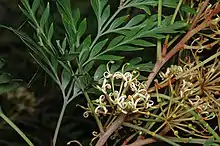| Fern-leaved stenocarpus | |
|---|---|
 | |
| Stenocarpus davallioides in Mt Annan Botanic Gardens | |
| Scientific classification | |
| Kingdom: | Plantae |
| Clade: | Tracheophytes |
| Clade: | Angiosperms |
| Clade: | Eudicots |
| Order: | Proteales |
| Family: | Proteaceae |
| Genus: | Stenocarpus |
| Species: | S. davallioides |
| Binomial name | |
| Stenocarpus davallioides | |

Stenocarpus davallioides, commonly known as the fern-leaved stenocarpus,[2] is a species of flowering plant in the family Proteaceae and is endemic to north Queensland. It is a tree with simple or pinnate adult leaves, groups of creamy-green flowers and narrow oblong follicles.
Description
Stenocarpus davallioides is a tree that typically grows to a height of up to 40 m (130 ft) with a dbh of up to 160 cm (63 in) and some buttressing of the base. Young plants and coppice regrowth have finely divided, fern-like leaves up to 420 mm (17 in) long on a petiole up to 100 mm (3.9 in) long. Adult leaves are mainly simple, lance-shaped and 50–130 mm (2.0–5.1 in) long on a petiole 10–20 mm (0.39–0.79 in) long, but some are intermediate, resembling the juvenile leaves. The flower groups are arranged in leaf axils with up to fifteen flowers on a peduncle 15–40 mm (0.59–1.57 in) long, the individual flowers creamy-green and 8–12 mm (0.31–0.47 in) long, each on a pedicel 6–12 mm (0.24–0.47 in) long. Flowering mainly occurs in November and the fruit is a narrow oblong follicle up to 65 mm (2.6 in) long, containing up to eight winged seeds.[2][3][4]
Taxonomy
Stenocarpus davallioides was first formally described in 1988 by Donald Bruce Foreman and Bernard Hyland in the journal Muelleria from specimens collected by Hyland in 1975.[4][5] Davallia is a species of fern and the suffix -oides means "like" or "resembling".[6]
Distribution and habitat
Fern-leaved stenocarpus is native to northern Queensland, where it is found on Thornton Peak and Mount Lewis National Park, ranging from 600 to 1,260 m (1,970 to 4,130 ft) above sea level.[3]
Use in horticulture
This species is rarely cultivated, but can grow in subtropical climates, though its frost tolerance is unknown.[7]
References
- ↑ "Stenocarpus davallioides". Australian Plant Census. Retrieved 14 September 2021.
- 1 2 Frank Zich; Bernie Hyland; Trevor Whiffen; Raelee Kerrigan (2020). "Stenocarpus davallioides". Australian Tropical Rainforest Plants, Edition 8. Commonwealth Scientific and Industrial Research Organisation (CSIRO). Retrieved 15 September 2021.
- 1 2 "Stenocarpus davallioides". Australian Biological Resources Study, Department of Agriculture, Water and the Environment: Canberra. Retrieved 15 September 2021.
- 1 2 Foreman, Donald B.; Hyland, Bernard P.M. (1988). "New species of Buckinghamia F.Muell. and Stenocarpus R.Br. (Proteaceae) from northern Queensland". Muelleria. 6 (6): 419–422. Retrieved 15 September 2021.
- ↑ "Stenocarpus davallioides". APNI. Retrieved 15 September 2021.
- ↑ William T. Stearn (1992). Botanical Latin. History, grammar, syntax, terminology and vocabulary (4th ed.). Portland, Oregon: Timber Press. p. 456.
- ↑ Walters, Brian. "Stenocarpus davallioides". Australian Native Plants Society (Australia). Australian Native Plants Society (Australia). Retrieved 25 September 2019.